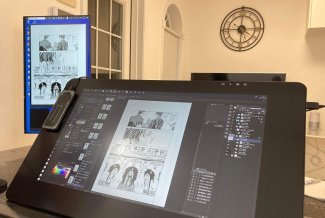There is a significant social component behind the success of sounds like reggaeton and artists like Puerto Rico’s Bad Bunny, ranging from the rejection of the insults directed at Latino migrants by President Donald Trump to its empowerment of a community. J Balvin (left) and Bad Bunny (right) perform Qué Pretendes (Who do you think you are?) at the 2019 MTV Video Music Awards.
Who would have thought that a Puerto Rican singer would be capable of challenging the leader of the most powerful country in the world? Or that reggaeton would play a major role in the marches that shook Latin America in late 2019? What might have seemed unthinkable just a few years ago is now a reality. The global revolution in Latino sounds is generating a profound change in contemporary society.
To understand the impact of the phenomenon, we should go back to 9 November 2016, when Donald Trump became president of the United States. “They’re [Mexico] sending people that have lots of problems, and they’re bringing those problems with us. They’re bringing drugs. They’re bringing crime. They’re rapists,” he railed during the campaign that brought him to the White House. He promised to build a wall and to send the “undesirables” back to their country of origin. His attacks against the Latino community were constant, open and vicious.
Around the same time, in November 2016, Benito Antonio Martínez Ocasio was an ordinary young man from Puerto Rico who worked in a supermarket and dreamed of becoming a musician. Four years later, Bad Bunny (his stage name) has become one of the most influential music stars in the world whilst Donald Trump is faced with the ballot box at the worst moment in his presidency, severely criticised for his mishandling of the coronavirus pandemic and by the Black Lives Matter movement.
“Donald Trump, president of racism. Your hate and tyranny, that is terrorism. Don’t stop the fight, keep your fists raised, let it be known that this is our home, that this is our land,” proclaimed the 26-year-old star in an interview for Time magazine.
What is exceptional about this is not the fact that an artist singing in Spanish criticised the ruler of a powerful country – we have seen other examples in recent history – but the real impact his words could have.
In the same way the statements made in years gone by Black artists like Jay-Z and Beyoncé helped propel Barack Obama to the presidency, today many are convinced that Latino celebrities like Bad Bunny will influence the 3 November elections in the United States, home to more than 60 million Latin Americans.
The community
“Latinos have been present in this country for several generations. They are an increasingly important part of society, aside from the terrible problem of racism there is today against the migrants coming from Central America,” says Tomas Cookman, perhaps the most influential figure of Latino origin (born in New York with Puerto Rican heritage) on the global music scene, as the founder of the Nacional Records label and the head of the Latin Alternative Music Conference (LAMC).
For this visionary entrepreneur – who has anticipated several of the phenomena that have marked popular culture in recent decades – despite the fact that there have always been Latino [or Hispanic] artists with international reach – Shakira, Gloria Estefan, Enrique Iglesias – “there have never been as many as there are now with success in other countries”.
He points to examples such as the cover of the Rolling Stone magazine dedicated to Bad Bunny in June of this year, and hugely influential figures such as Colombian reggaeton artist J Balvin or Spain’s innovative flamenco fusion singer Rosalía, who are influencing young people every day on social media, where they are followed by millions of fans.
The growing influence of new Latino pop stars is the subject of a study by Ecuadorian Priscila Álvarez.
“Their songs are not cultural pieces made from scratch, they contain specific codes that connect with young people and create identities,” she says.
The researcher from Pompeu Fabra University in Barcelona nonetheless points out that the messages these artists send out are not always anti-system. She compares their entry into the mainstream (and how their content is whitewashed and standardised to succeed) with what is suggested in the theories developed by sociologist Rosalind Gill, who warns of the dangers of making struggles such as feminism fashionable.
But the fact is that terms such as “Latino gang” or “the community” are already being used to refer to these artists who rose to fame during the years of the Trump presidency without really having anything in common beyond a sense of shared origin or language.
“It’s the first time in the history of music that the Spanish-language has been so prominent, and that gives us a great deal of power as Latino artists,” says Nathy Peluso, an Argentinian singer who has lived in Spain for several years and has more than a million monthly listeners on her Spotify profile.
Latin American Spring
When images appeared in the summer of 2019 of demonstrations led by Ricky Martin, Bad Bunny and Residente (from Calle 13) in Puerto Rico, some thought it was no more than a curiosity. Nothing could be further from the truth: the movement went on to be dubbed ‘the Reggaeton Revolution’, given the importance of songs like Afilando los Cuchillos (Sharpening the Knives), and the mobilisations led to the resignation of Governor Ricardo Roselló.
That wave of opposition to the ruling elites spread to other countries in the region during the second half of 2019 and the media began to talk about a ‘Latin American Spring’, in reference to the protests that shook the Arab world between 2010 and 2012. New Latino music suddenly burst on to the political stage.
“Something is changing, the government has never taken us seriously before. The energy in these marches is that of a new generation demanding change, and we as artists must play a part in that revolution,” said Chilean rapper Gianluca in October last year, as the streets of his country were literally set ablaze in the wake of the military repression.
The 23-year-old was one of the young people who recorded a new version of Victor Jara’s revolutionary classic, El Derecho de Vivir en Paz (The Right to Live in Peace), in support of the protesters. Soon after, Gianluca’s compatriot Mon Laferte appeared at the Latin Grammy awards ceremony in Las Vegas, where she was one of the night’s winners, with the message “In Chile they torture, rape and kill” written across her bare chest.
In some way or another, local music stars helped bring the protests into the mainstream, be it by singing protest songs or lending their image to the struggle.
In Ecuador, the banging of pots and pans resounded in the streets with the support of artists such as Mateo Kingman and Huaira, whilst in Bolivia, the soundtrack to the Indigenous protests were the songs of Kaypi Rap and MZ Racheal La Dama, and in Colombia, artists such as Edson Velandia and Totó La Momposina echoed the popular protest chant “¡El pueblo no se rinde, carajo!” (The people don’t give up, damn it!).
“I feel there is a disconnect between all Latin American governments and the real needs of the people. It is important that people demonstrate, to call for more attention from those in power,” said Colombian rock-pop star Juanes at the time.
“Nowadays, whatever these artists say has a huge impact. There are many people listening to their opinions, especially the younger ones,” says Cookman.
Reggaeton: a uniting force
Although the momentum of the Latin American Spring has been slowed by the COVID-19 health emergency, the Latino music boom has not yet reached its peak. “The numbers never lie and they reflect the tremendous growth seen in recent years,” says Inma Grass, head of Altafonte, a music distributor active in several south American countries, Spain, Portugal, Mexico and the United States.
To illustrate the growing importance of the Latino sector in the multi-million dollar music industry (and therefore in society), the expert shares her insight: “I’ve been familiar with the work of multinationals for decades, and the focus was always on the English-language sector until a few years ago, when they began to look at the Latino sector as a more attractive market.”
Confirmation of this came during the Super Bowl halftime show in February of this year, an event followed by millions of people: four Latinos (Shakira, Jennifer Lopez, Bad Bunny and J Balvin) got people dancing and commenting, live and after the event, on the biggest social media sites on the planet.
Platforms like Spotify have helped to democratise access to music and to create a new shared identity: that of a potentially massive audience that now wants to listen to music in its own language, Spanish.
One of the keys to this upswing in Latino music has been a hard-hitting, catchy beat that was born in Panama and popularised in Puerto Rico, and has long carried the stigma of violence and machismo: reggaeton.
“The notion of Latino pride is very present in contemporary music, including that of Spain, you just have to speak the same language. That, linked to the present, is symbolised by reggaeton. There is an element of patriotism to it, ranging from opposition to Trump to the empowerment of the traditions in each region,” says researcher Priscila Álvarez.
DJ Flaca, an Argentinian who arrived in Spain when she was young, experienced this change of perception towards reggaeton at first hand. She suffered racism at school, was afraid to play Don Omar’s hits at her parties and is now an icon on the new scene with her hugely popular reggaeton sessions.
“We are living through a time of creative diaspora: it is a time when we the children of migrants live, exist and make music outside our countries of origin, mixing everything with everything, connecting with the Spaniards of our generation,” says the artist, whose real name is Sofia Conti.
Carles Feixa, professor of social anthropology at Pompeu Fabra University, has been analysing youth cultures since 2005. He sees reggaeton as a bond that now unites different sectors of society, regardless of skin colour, sexual orientation or purchasing power. “It has come out of the ghetto and is fostering inclusion,” he says.
In European cities receiving migrants from Latin America, such as Madrid, Barcelona, Lisbon, Turin, Milan, Genoa or Berlin, sounds such as reggaeton unite, bringing together local and Dominican, Colombian, Honduran or Ecuadorian youngsters in parks, parties and nightspots.
“This new wave represents a new way of understanding the world. The public created this movement and brought together people who had nothing in common, other than enjoying dancing. It has opened the door to everyone, regardless of how fair or dark your skin is,” says Chilean Tomasa del Real, creator of the neo perreo genre.
The question is: why does it continue to stir such strong negative reactions? Having danced to it since she was a teenager and, years later, doing research into the topic, Álvarez has an answer: “In Spain, there is an element of racism, of disparaging what comes from outside, and in countries like mine, or others in Latin America, the rejection comes from the economic sphere, as a marker of social class.”
Mala Rodríguez, one of the biggest names in Spanish hip-hop, agrees with her. “For years Latino music, in general, has been perceived in Spain as something inferior, it has been looked down on. Luckily, this is starting to change, but some people find it hard to accept reggaeton. They don’t realise that, deep down, there’s a racism issue, they think they’re more sophisticated because they listen to rock.’’
As the genre makes headway, some wonder if it is not just a passing phase. “If it is a trend, it’s been around for a long time already. Everything is cyclical. Other genres will come and go but reggaeton will keep evolving, branching out towards other trends, fusing with electronic, hip hop and other kinds of music,” says Grass.
Cookman is categorical: “The upsurge in Latin music is here to stay.” And it goes beyond reggaeton, ranging from Dominican dembow to Andean electro-cumbia. He sees it as a phenomenon like hip hop in the United States at the end of the 1970s, an expression of the street that came out of Latino and African-American communities and became part of popular culture with a strong social component. “It’s an unstoppable phenomenon,” he insists.










